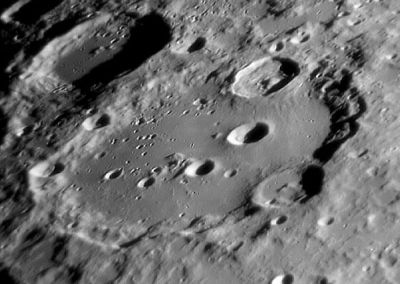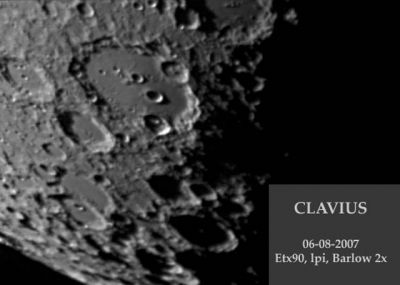Difference between revisions of "Clavius"
(Created page with "<div id="content_view" class="wiki" style="display: block"> =Clavius= {| class="wiki_table" | Lat: 58.8°S, Long: 14.1°W, Diam: 245 km, Depth: 4.9 km, [/R%C3%BCkl%2072 R...") |
|||
| (3 intermediate revisions by the same user not shown) | |||
| Line 3: | Line 3: | ||
{| class="wiki_table" | {| class="wiki_table" | ||
| | | | ||
| − | Lat: 58.8°S, Long: 14.1°W, Diam: 245 km, Depth: 4.9 km, [ | + | Lat: 58.8°S, Long: 14.1°W, Diam: 245 km, Depth: 4.9 km, [[R%C3%BCkl%2072|Rükl: 72]], Nectarian<br /> |
|} | |} | ||
| − | [http://www.lpod.org/coppermine/displayimage.php?pid=296&fullsize=1 [[Image: | + | [http://www.lpod.org/coppermine/displayimage.php?pid=296&fullsize=1 [[Image:Normal_clav_neu_enl.jpg|external image normal_clav_neu_enl.jpg]]][http://www.lpod.org/coppermine/displayimage.php?pid=2087&fullsize=1 [[Image:Normal_L06084.jpg|external image normal_L06084.jpg]]]<br /> Left: ''[http://lpod.org/coppermine/displayimage.php?pos=-296 Dietmar Hager]'', Right: ''[http://lpod.org/coppermine/displayimage.php?pos=-2087 Eric Soucy-Lacroix]''<br /> <br /> <div id="toc"> |
| − | + | ||
| − | |||
==Images== | ==Images== | ||
[http://www.lpod.org/coppermine/thumbnails.php?album=search&type=full&search=Clavius LPOD Photo Gallery] [http://www.lpi.usra.edu/resources/lunar_orbiter/bin/srch_nam.shtml?Clavius%7C0 Lunar Orbiter Images]<br /> <br /> | [http://www.lpod.org/coppermine/thumbnails.php?album=search&type=full&search=Clavius LPOD Photo Gallery] [http://www.lpi.usra.edu/resources/lunar_orbiter/bin/srch_nam.shtml?Clavius%7C0 Lunar Orbiter Images]<br /> <br /> | ||
==Maps== | ==Maps== | ||
| − | ''([ | + | ''([[LAC%20zone|LAC zone]] 126D1)'' [http://www.lpi.usra.edu/resources/mapcatalog/LAC/lac126/ LAC map] [http://www.lpi.usra.edu/resources/mapcatalog/usgs/I706/ Geologic map]<br /> <br /> |
==Description== | ==Description== | ||
<br /> | <br /> | ||
==Description: Elger== | ==Description: Elger== | ||
| − | ''([ | + | ''([[IAU%20directions|IAU Directions]])'' CLAVIUS.--There are few lunar observers who have not devoted more or less attention to this beautiful formation, one of the most striking of telescopic objects. However familiar we may consider ourselves to be with its features, there is always something fresh to note and to admire as often as we examine its apparently inexhaustible details. It is 142 miles from side to side, and includes an area of at least 16,000 square miles within its irregular circumvallation, which is only comparatively slightly elevated above the bright plateau on the E., though it stands at least 12,000 feet above the depressed floor. At a point on the S.E. a peak rises nearly 17,000 feet above the interior, while on the W. the cliffs are almost as lofty. There are two remarkable ring-plains, each about 25 miles in diameter, associated, one with the N., and the other with the S. wall, the floors of both abounding in detail. The latter, however, is the most noteworthy on account of the curious corrugations visible soon after sunrise on the outer N. slope of its wall, resembling the ribbed flanks of some of the Java volcanoes. There are five large craters on the floor of Clavius, following a curve convex to the N., and diminishing in size from E. to W. The most easterly stands nearly midway between the two large ring-plains on the walls, the second (about two- thirds its area) is associated with a complex group of hills and smaller craters. Both these objects have central mountains. In addition to this prominent chain, there are innumerable craters of a smaller type on the floor, but they are more plentiful on the S. half than elsewhere. On the S.W. wall are three very large depressions. On the broad massive N.W. border, the bright summit ridge and the many transverse valleys running down from it to the floor, are especially interesting features. There are very clear indications of "faulting" on a vast scale where this broad section of the wall abuts on the N. side of the formation.<br /> <br /> |
==Description: Wikipedia== | ==Description: Wikipedia== | ||
[http://en.wikipedia.org/wiki/Clavius_(crater) Clavius]<br /> <br /> | [http://en.wikipedia.org/wiki/Clavius_(crater) Clavius]<br /> <br /> | ||
==Additional Information== | ==Additional Information== | ||
| − | * Depth data from [ | + | * Depth data from [[Kurt%20Fisher%20Crater%20Depths|Kurt Fisher database]]<br /> Pike, 1976: 4.9 km<br /> Westfall, 2000: 4.9 km<br /> Cherrington, 1969: 4.9 km |
| − | * Satellite crater Clavius G is on the [ | + | * Satellite crater Clavius G is on the [[ALPO%20list%20of%20banded%20craters|ALPO list of banded craters]] |
<br /> | <br /> | ||
==Clair-Obscur phenomenon in Clavius== | ==Clair-Obscur phenomenon in Clavius== | ||
| − | * One of the most impressive lunar Clair-Obscur phenomena is the illuminated ring appearance of the larger craters on the floor of '''Clavius''', always observable during the local sunrise hours. According to a vague memory of something which I heard during one of the moonlit nights at the Public Observatory of my city in Flanders-Belgium, some dedicated moon observers over there called this phenomenon the "'''''Ears of Clavius'''''" (perhaps it should have been the "'''''Eyes of Clavius'''''"?). A fine little sketch of this phenomenon is included on page 268 of the Dutch moonbook ''Op Ontdekking in het Maanland'' by A.J.M.Wanders (1949). <span class="membersnap">- | + | * One of the most impressive lunar Clair-Obscur phenomena is the illuminated ring appearance of the larger craters on the floor of '''Clavius''', always observable during the local sunrise hours. According to a vague memory of something which I heard during one of the moonlit nights at the Public Observatory of my city in Flanders-Belgium, some dedicated moon observers over there called this phenomenon the "'''''Ears of Clavius'''''" (perhaps it should have been the "'''''Eyes of Clavius'''''"?). A fine little sketch of this phenomenon is included on page 268 of the Dutch moonbook ''Op Ontdekking in het Maanland'' by A.J.M.Wanders (1949). <span class="membersnap">- DannyCaes <small>Aug 28, 2015</small></span> |
<br /> | <br /> | ||
==Nomenclature== | ==Nomenclature== | ||
| Line 34: | Line 33: | ||
<br /> | <br /> | ||
==LPOD Articles== | ==LPOD Articles== | ||
| − | [http:// | + | [http://www2.lpod.org/wiki/December_25,_2006 A Christmas Present.]<br /> [http://www2.lpod.org/wiki/November_19,_2006 Where's Clavius?]<br /> [http://www2.lpod.org/wiki/October_16,_2006 Image Planning and Presentation.]<br /> [http://www2.lpod.org/wiki/July_22,_2006 Swept Away]<br /> [http://www2.lpod.org/wiki/October_8,_2004 What a Difference a Day Makes]<br /> [http://www2.lpod.org/wiki/March_8,_2004 Sunset over Clavius]<br /> [http://lpod.wikispaces.com/July%2012%2C%202009 Skimming the Surface]<br /> <br /> |
==Lunar 100== | ==Lunar 100== | ||
| − | [ | + | [[Lunar%20100|L9]]: Lacks basin features in spite of its size.<br /> <br /> |
==Bibliography== | ==Bibliography== | ||
A Portfolio of Lunar Drawings (Harold Hill), pages 118, 119, 120, 121.<br /> <br /> | A Portfolio of Lunar Drawings (Harold Hill), pages 118, 119, 120, 121.<br /> <br /> | ||
---- | ---- | ||
| − | + | </div> | |
Latest revision as of 02:44, 16 April 2018
Contents
Clavius
|
Lat: 58.8°S, Long: 14.1°W, Diam: 245 km, Depth: 4.9 km, Rükl: 72, Nectarian |


Left: Dietmar Hager, Right: Eric Soucy-Lacroix
Images
LPOD Photo Gallery Lunar Orbiter Images
Maps
(LAC zone 126D1) LAC map Geologic map
Description
Description: Elger
(IAU Directions) CLAVIUS.--There are few lunar observers who have not devoted more or less attention to this beautiful formation, one of the most striking of telescopic objects. However familiar we may consider ourselves to be with its features, there is always something fresh to note and to admire as often as we examine its apparently inexhaustible details. It is 142 miles from side to side, and includes an area of at least 16,000 square miles within its irregular circumvallation, which is only comparatively slightly elevated above the bright plateau on the E., though it stands at least 12,000 feet above the depressed floor. At a point on the S.E. a peak rises nearly 17,000 feet above the interior, while on the W. the cliffs are almost as lofty. There are two remarkable ring-plains, each about 25 miles in diameter, associated, one with the N., and the other with the S. wall, the floors of both abounding in detail. The latter, however, is the most noteworthy on account of the curious corrugations visible soon after sunrise on the outer N. slope of its wall, resembling the ribbed flanks of some of the Java volcanoes. There are five large craters on the floor of Clavius, following a curve convex to the N., and diminishing in size from E. to W. The most easterly stands nearly midway between the two large ring-plains on the walls, the second (about two- thirds its area) is associated with a complex group of hills and smaller craters. Both these objects have central mountains. In addition to this prominent chain, there are innumerable craters of a smaller type on the floor, but they are more plentiful on the S. half than elsewhere. On the S.W. wall are three very large depressions. On the broad massive N.W. border, the bright summit ridge and the many transverse valleys running down from it to the floor, are especially interesting features. There are very clear indications of "faulting" on a vast scale where this broad section of the wall abuts on the N. side of the formation.
Description: Wikipedia
Additional Information
- Depth data from Kurt Fisher database
Pike, 1976: 4.9 km
Westfall, 2000: 4.9 km
Cherrington, 1969: 4.9 km - Satellite crater Clavius G is on the ALPO list of banded craters
Clair-Obscur phenomenon in Clavius
- One of the most impressive lunar Clair-Obscur phenomena is the illuminated ring appearance of the larger craters on the floor of Clavius, always observable during the local sunrise hours. According to a vague memory of something which I heard during one of the moonlit nights at the Public Observatory of my city in Flanders-Belgium, some dedicated moon observers over there called this phenomenon the "Ears of Clavius" (perhaps it should have been the "Eyes of Clavius"?). A fine little sketch of this phenomenon is included on page 268 of the Dutch moonbook Op Ontdekking in het Maanland by A.J.M.Wanders (1949). - DannyCaes Aug 28, 2015
Nomenclature
- Christopher Clavius, (March 25, 1538 – February 12, 1612) was a German Jesuit mathematician and astronomer who was the main architect of the modern Gregorian calendar. In his last years he was probably the most respected astronomer in Europe and his textbooks were used for astronomical education for over fifty years in Europe and even in more remote lands (on account of being used by missionaries).
- His name was Christoph Klau. The Galileo Project at Rice University has a good article on Clavius' intellectual life. Though he was primarily a mathmetician (his body of work is called Opera Mathematica) and his most acclaimed accomplishment is the Gregorian calendar, it was in a Commentary on the Sphere of Sacrobosco that he joined the cosmological debates of his time, coming down in favor of the Ptolemaic system, though he cautiously admitted that the observations of Galileo needed explanation in his final version of the commentary. James Lattis of University of Wisconsin-Madison has a "very select" bibliography on Clavius, which includes his own work, Between Copernicus and Galileo: Christoph Clavius and the Collapse of Ptolemaic Cosmology (available from Amazon.com). Since Clavius was a Jesuit priest, Catholic scholars have taken a particular interest in his life and work. The Clavius Groupat Fairfield University is a group of Catholic mathmeticians carrying on scientific work within the faith in summer workshops. Click herefor their own website on Clavius.
- According to Chart 107 in the Times Atlas of the Moon, a tiny hill on the floor of Clavius (west of Clavius D) seems to have been called Clavius Theta.
- Terra Photographica (William Radcliff Birt's name for the chaotic looking region east of Clavius) (between Clavius and Zach, with Birt's Pollock as an extra).
LPOD Articles
A Christmas Present.
Where's Clavius?
Image Planning and Presentation.
Swept Away
What a Difference a Day Makes
Sunset over Clavius
Skimming the Surface
Lunar 100
L9: Lacks basin features in spite of its size.
Bibliography
A Portfolio of Lunar Drawings (Harold Hill), pages 118, 119, 120, 121.